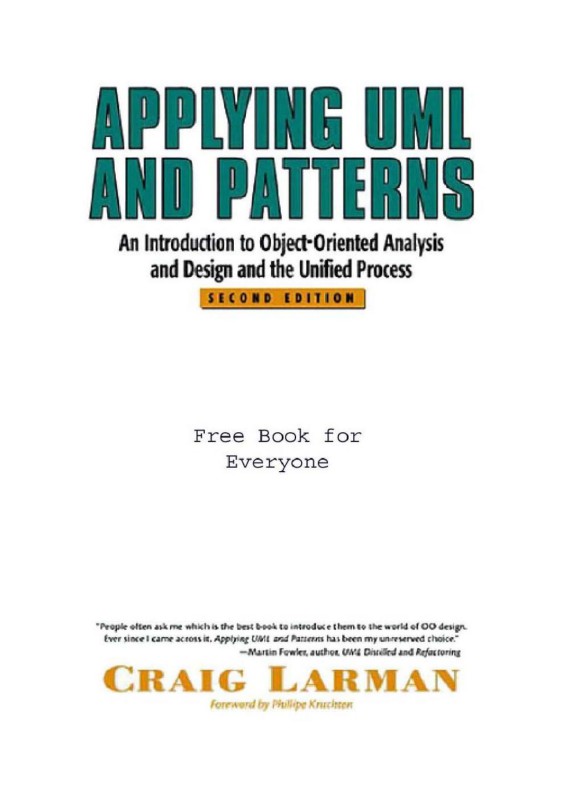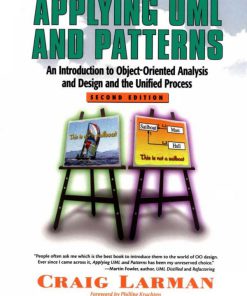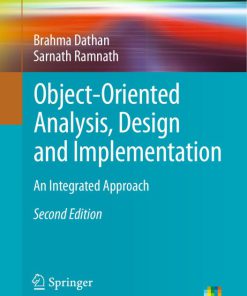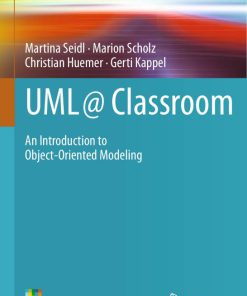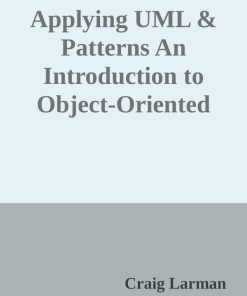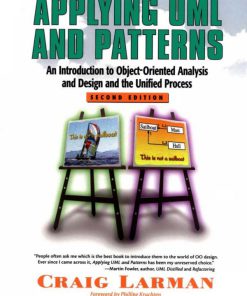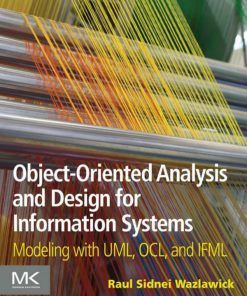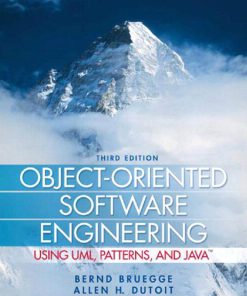Applying UML and Patterns An Introduction to Object Oriented Analysis and Design and the Unified Process 2nd edition by Craig Larman ISBN ‎ 0130925691 978-0130925695
$50.00 Original price was: $50.00.$25.00Current price is: $25.00.
Authors:Craig Larman , Series:Computer Science [46] , Tags:Computers; Programming; Object Oriented , Author sort:Larman, Craig , Ids:9780130925695 , Languages:Languages:eng , Published:Published:Dec 2002 , Publisher:Prentice Hall Professional , Comments:Comments:The world’s no.1 best-selling introduction to object-oriented analysis/design, iterative development, and the UML-now completely updated! Applying UML and Patterns, second edition, helps any developer or student master the core principles and best practices of object-oriented analysis and design (OOA/D)-not just drawing UML, but really applying it in the context of software design. Renowned object technology and iterative methods leader Craig Larman presents three iterations of a single, cohesive case study, incrementally introducing the critical skills of OOA/D, while emphasizing the most essential activities, principles, and patterns. Coverage includes: *Requirements and Use Cases: Identifying and recording requirements *Domain Object Modeling: Understanding domain objects of interest, their attributes, and relationships *Architecture: Creating layered architectures that maximize applicationflexibility, robustness, and maintainability *Essential Object Design: Mastering key skills, including assigning responsibilities to objects, and designing collaborations with principles such as Information Expert, Indirection, and Protected Variations *Design Patterns: Creating robust objec
Applying UML and Patterns: An Introduction to Object-Oriented Analysis and Design and the Unified Process 2nd edition by Craig Larman – Ebook PDF Instant Download/Delivery. 0130925691, 978-0130925695
Full download Applying UML and Patterns: An Introduction to Object-Oriented Analysis and Design and the Unified Process 2nd edition after payment

Product details:
ISBN 10: 0130925691
ISBN 13: 978-0130925695
Author: Craig Larman
This edition contains Larmans usual accurate and thoughtful writing. It is a very good book made even better.
Alistair Cockburn,author,Writing Effective Use CasesandSurviving OO ProjectsToo few people have a knack for explaining things. Fewer still have a handle on software analysis and design. Craig Larman has both.
John Vlissides,author,Design PatternsandPattern HatchingPeople often ask me which is the best book to introduce them to the world of OO design. Ever since I came across it Applying UML and Patterns has been my unreserved choice.
Martin Fowler,author,UML DistilledandRefactoringThis book makes learning UML enjoyable and pragmatic by incrementally introducing it as an intuitive language for specifying the artifacts of object analysis and design. It is a well written introduction to UML and object methods by an expert practitioner.
Cris Kobryn,Chair of the UML Revision Task Force and UML 2.0 Working Group
- A brand new edition of the worlds most admired introduction to object-oriented analysis and design with UML
- Fully updated for UML 2 and the latest iterative/agile practices
- Includes an all-new case study illustrating many of the books key points
Applying UML and Patterns is the worlds #1 business and college introduction to thinking in objectsand using that insight in real-world object-oriented analysis and design. Building on two widely acclaimed previous editions, Craig Larman has updated this book to fully reflect the new UML 2 standard, to help you master the art of object design, and to promote high-impact, iterative, and skillful agile modeling practices.
Developers and students will learn object-oriented analysis and design (OOA/D) through three iterations of two cohesive, start-to-finish case studies. These case studies incrementally introduce key skills, essential OO principles and patterns, UML notation, and best practices. You wont just learn UML diagramsyoull learn how to apply UML in the context of OO software development.
Drawing on his unsurpassed experience as a mentor and consultant, Larman helps you understand evolutionary requirements and use cases, domain object modeling, responsibility-driven design, essential OO design, layered architectures, Gang of Four design patterns, GRASP, iterative methods, an agile approach to the Unified Process (UP), and much more. This editions extensive improvements include
- A stronger focus on helping you master OOA/D through case studies that demonstrate key OO principles and patterns, while also applying the UML
- New coverage of UML 2, Agile Modeling, Test-Driven Development, and refactoring
- Many new tips on combining iterative and evolutionary development with OOA/D
- Updates for easier study, including new learning aids and graphics
- New college educator teaching resources
- Guidance on applying the UP in a light, agile spirit, complementary with other iterative methods such as XP and Scrum
- Techniques for applying the UML to documenting architectures
- A new chapter on evolutionary requirements, and much more
Applying UML and Patterns, Third Edition,is a lucid and practical intr
Applying UML and Patterns: An Introduction to Object-Oriented Analysis and Design and the Unified Process 2nd Table of contents:
Preface
- Acknowledgments
- Introduction to the Second Edition
- Overview of the Book
Chapter 1: Introduction to Object-Oriented Analysis and Design
1.1 What is Object-Oriented Analysis and Design?
1.2 The Unified Process and UML
1.3 The Role of Patterns in OOAD
1.4 Key Concepts: Objects, Classes, and Responsibilities
1.5 The Lifecycle of Software Development
1.6 The Importance of Iteration in OOAD
Chapter 2: The Unified Process
2.1 What is the Unified Process?
2.2 Phases of the Unified Process: Inception, Elaboration, Construction, and Transition
2.3 Iterative and Incremental Development
2.4 The Workflow in the Unified Process
2.5 Roles and Responsibilities in the Unified Process
2.6 Applying the Unified Process in Real Projects
Chapter 3: Use Cases and Requirements Analysis
3.1 What Are Use Cases?
3.2 Writing Effective Use Cases
3.3 Use Case Diagrams in UML
3.4 Identifying Actors and Use Cases
3.5 Use Case Realization and System Design
3.6 Integrating Use Cases with UML Diagrams
Chapter 4: Class Design and Modeling
4.1 Introduction to Class Modeling
4.2 The Importance of Class Diagrams
4.3 Identifying Classes, Attributes, and Methods
4.4 Associations, Multiplicities, and Aggregation
4.5 Generalization and Specialization
4.6 Patterns for Designing Classes
Chapter 5: Interaction Diagrams
5.1 What Are Interaction Diagrams?
5.2 Sequence Diagrams: Message Passing in Time
5.3 Collaboration Diagrams: Message Passing in Space
5.4 Using Sequence and Collaboration Diagrams Together
5.5 Identifying and Modeling Interactions
5.6 Design Patterns and Interaction Diagrams
Chapter 6: State Diagrams and Modeling
6.1 Introduction to State Diagrams
6.2 States, Transitions, Events, and Actions
6.3 Finite State Machines in Object-Oriented Design
6.4 Modeling State Changes in Objects
6.5 Using State Diagrams in Analysis and Design
6.6 Example: Modeling a Workflow with State Diagrams
Chapter 7: Component and Deployment Diagrams
7.1 Introduction to Component and Deployment Diagrams
7.2 Components, Interfaces, and Relationships
7.3 Modeling System Components and Subsystems
7.4 Deployment Diagrams: Representing Physical Architecture
7.5 The Role of Components and Deployment in OOAD
Chapter 8: Object-Oriented Design Patterns
8.1 Introduction to Design Patterns
8.2 The Gang of Four (GoF) Design Patterns
8.3 Creational, Structural, and Behavioral Patterns
8.4 The Role of Patterns in Reusable and Maintainable Code
8.5 Applying Patterns in OOAD Projects
8.6 Examples of Common Design Patterns in Practice
Chapter 9: Applying UML and Patterns in the Unified Process
9.1 Mapping UML to the Unified Process Phases
9.2 Iterative Design and Modeling with UML
9.3 Incorporating Patterns into the Unified Process
9.4 Case Study: Applying the Unified Process to a Software Project
9.5 Best Practices for Modeling and Design
Chapter 10: Advanced Topics in Object-Oriented Analysis and Design
10.1 Architectural Patterns and Styles
10.2 Refactoring and Reengineering
10.3 Distributed Systems and OOAD
10.4 Applying UML for Real-Time Systems
10.5 Design and Modeling for Performance and Scalability
Chapter 11: Object-Oriented Design and Development Tools
11.1 Tools for Object-Oriented Design and Modeling
11.2 Integrated Development Environments (IDEs)
11.3 CASE Tools for UML Modeling
11.4 Reverse Engineering and Code Generation Tools
11.5 Best Practices for Tool Integration in OOAD
Chapter 12: Case Study: A Real-World Software Development Project
12.1 Overview of the Case Study Project
12.2 Gathering Requirements and Writing Use Cases
12.3 Designing the System with UML
12.4 Applying Design Patterns and Unified Process
12.5 Implementing the Design
12.6 Evaluating and Refining the System
Appendices
- A: Glossary of Terms
- B: Additional Resources for UML and OOAD
- C: Recommended Reading
- D: Further Study in Object-Oriented Design and Patterns
People also search for Applying UML and Patterns: An Introduction to Object-Oriented Analysis and Design and the Unified Process 2nd :
craig larman applying uml and patterns
larman c applying uml and patterns
applying uml and patterns 3rd edition pdf
applying uml and patterns 3rd edition pd
applying uml and patterns craig larman pdf

